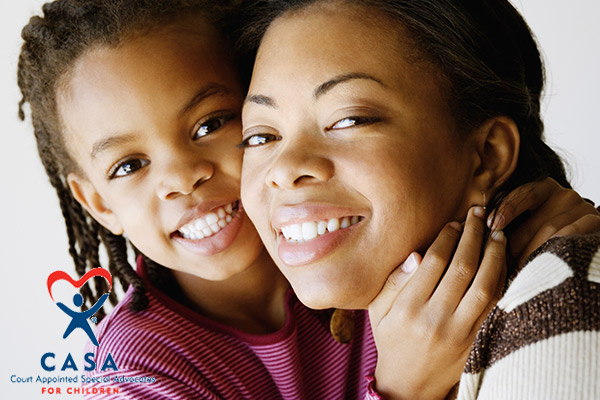How CASA Helps Reunite Families

For many parents whose children have been removed from the home, Child Protective Services (CPS) may seem like the “villain” who stole their children, rather than as a resource to help stabilize and preserve their family and to protect children from abuse and neglect.
For case workers, attorneys, and judges, it’s often hard to see that a parent has changed, or to believe that the change will last, when they’ve seen the conditions that led to the child being removed.
For children, though, many want to be with their parents despite what has happened. And most do better in their own families, even when the situation isn’t perfect. There may not be a white picket fence, two parents, or a savings account, but if the child is safe, loved, and provided for, they can heal from past hurts and thrive.
How Does CASA Fit In?
A CASA (Court Appointed Special Advocate) is in a unique position to see all sides of the child’s case, to be the voice for what is in the child’s best interest, and to advocate on their behalf. They are often instrumental in determining whether reunification occurs or not.
Reunifying broken families, helping them to become healthy and whole, is a large part of an Advocate’s job. They recommend appropriate services and help to associate as many healthy adult connections for the child as they can find. These connections help to support the child throughout their journey in the child welfare system, and after.
Reunification works when the parent(s) fulfill their responsibility to provide a safe and healthy environment for their child. This can mean taking parenting classes, getting individual and family counseling and treatment for drug or alcohol abuse, maintaining a job and clean and safe residence, and keeping people who are unsafe away from their child. When reunification fails, most often it’s because a safe environment cannot be provided or maintained.
Barbara has been an Advocate for 2 years. Here is what she has to say about reunification:
“In one of my cases that ended in reunification, the mom had initially not been able to protect her children. But she had therapy with a good mental health professional during the months of the case. The children were placed back with mom. She was severely tested when her boyfriend tried to hurt the children again. But she was strong enough to take the children and leave.
Parents should always be offered the services they need to be successful in reuniting with their children. If they don’t take advantage of this help, there’s little hope for reunification. And that’s a great loss to children. They are much better off to grow up with their birth parents—or, if that’s not possible, to live with a relative.”
Family Reunification and the Law
The 1980 Adoption Assistance and Child Welfare Act as well as the 1997 Adoption and Safe Families Act ensure that the prevention of removal and family reunification are legal priorities when a child initially becomes involved in the child welfare system. Because reunification can be difficult or the family circumstances so severe that it may seem impossible, concurrent planning is common. Concurrent planning is where the caseworker plans both for reunification and permanent placement with another family.
Reuniting the Terrance Family
In some cases, children are reunited with their parents even after it seemed all hope was lost for them to be a family again. One example is the Terrance family. Both parents were on drugs and their choices kept worsening. They failed to attend scheduled visitations, or would show up high, unannounced, demanding to see their children. Counseling appointments were missed and they refused treatment. The courts were moving toward terminating parental rights.
Because the one child’s Advocate and a therapist felt it was important for a sibling to be adopted into the same family, they secured an extension before parental rights were terminated, which proved to be the extra time the birth mother needed. The children’s mother entered a treatment program and did so well with sobriety that she was hired by the same treatment center—a good job with benefits. She paid off court fees and regained her driver’s license.
“Last winter I realized she [the mother] was going to make it, so I quickly switched gears and started working towards reunification,” says the CASA volunteer. The child was recently returned to her mother, and her older sister will soon join her.”
For this reason, it is important to strive for healthy relationships between the birth parents, foster parents, caseworkers, therapists, and CASA volunteers. The more all of the parties work together, the better the outcome for the child. CASA Advocates are in a unique position to mentor the parents, collaborate with others involved and help to foster positive interactions in those relationships, and to really get a 360° perspective of the child’s case.
When a CASA volunteer gets to see the child they’ve been advocating for reunited with their parent(s) in a safe and healthy home, all of the time, tears, and frustrations of being an Advocate melt away into joy, and often humility, when they realize that they played a part in preserving a family.
